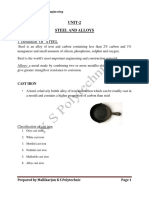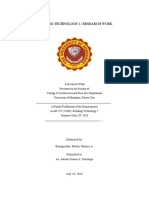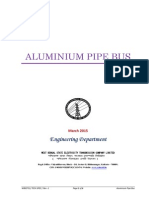Mse Notes - Unit - 3
Mse Notes - Unit - 3
Uploaded by
337-ME- KIRTHAN DEVADIGACopyright:
Available Formats
Mse Notes - Unit - 3
Mse Notes - Unit - 3
Uploaded by
337-ME- KIRTHAN DEVADIGAOriginal Description:
Original Title
Copyright
Available Formats
Share this document
Did you find this document useful?
Is this content inappropriate?
Copyright:
Available Formats
Mse Notes - Unit - 3
Mse Notes - Unit - 3
Uploaded by
337-ME- KIRTHAN DEVADIGACopyright:
Available Formats
Department of Mechanical Engineering
UNIT-3
NON-FERROUS METALS AND ALLOYS
• A non-ferrous metal is a metal, including alloys, that does not contain iron (ferrite) in
appreciable amount.
• Non-ferrous metals include aluminum, copper, lead, zinc and tin, as well as
precious metals like gold and silver .alloys such as Brass.
• Their main advantage over ferrous materials is their malleability.
• They find there application in industries because of there ease of
fabrication(forging,casting,rolling,welding,and machining).
• They are good conductor of heat and electricity,resistance to corrosion.
• At high temperature there strength will be lowered and shrinkage will be more than ferrous
materials
Types of Non-ferrous metals
1. Copper
2. Aluminium
3. Zinc
4. Tin
5. Lead
6. Cobalt
7. Nickel
Prepared by Mallikarjun K S Polytechnic Page 1
Department of Mechanical Engineering
8. Chromium
9. Magnesium…etc
1.Copper
Copper is a chemical element with the symbol Cu (from Latin: cuprum) and atomic
number 29. It is a soft, malleable, and ductile metal with very high thermal and
electrical conductivity. A freshly exposed surface of pure copper has a pinkish-
orange color.
Properties of copper
1. It is reddish brown in color
2. It is soft,strong,tough,malleable and ductile.
3. It becomes brittle just before melting.
4. It resists corrosion.
5. It is good conductor of both heat and electricity next to silver.
6. It can forged,soldered,rolled,and drawn into thin wires.
7. Specific gravity is 8.93,melting point is 1083.
Prepared by Mallikarjun K S Polytechnic Page 2
Department of Mechanical Engineering
Uses of copper.
• It is used in making cables and wires for electric appliances.
• It is used for electroplating, electrotyping.
• Used for the manufacture of utensils and making of copper alloys.
• It is used in roofing, plumbing, industrial machinery(Heat exchangers).
• Most copper is used in electrical equipment such as wiring and motors.
ALLOYS OF COPPER
• Copper alloys are broadly classified into two groups
1. Brasses or copper-zinc alloys
2. Bronzes or copper-tin alloys
Brass
• Brass are primarily alloys of copper and zinc with small quantity of other
elements.
• Brass is most commonly used copper alloy
• Brass have greater tensile strength than copper metal,but have lower thermal
and electrical conductivity.
• They have high resistivity to corrosion,they are soft ductile and malleable.
• The machinability and hardness can be increased by varying the elements in
brass.
• The melting point of brass varies from 800-1000⁰C
Prepared by Mallikarjun K S Polytechnic Page 3
Department of Mechanical Engineering
TYPES OF BRASS
1. Muntz metal
2. White brass
3. Yellow brass
4. Catridge brass
5. Delta metal
6. Low brass
7. Red brass
8. Naval brass
Properties and applications of brass
• Brass is the generic term for a range of copper-zinc alloys with differing
combinations of properties, including strength, machinability, ductility,
wear-resistance, hardness, colour, electrical and thermal conductivity,
hygiene and corrosion resistance.
• Applications for Brass
1. Locks.
2. Gears.
3. Bearings.
4. Valves.
5. Braces.
6. Brackets.
Prepared by Mallikarjun K S Polytechnic Page 4
Department of Mechanical Engineering
7. Base plates
Bronze
• Bronze is one of the earliest metals known to man. It is defined as
an alloy made of copper and another metal, usually tin. Compositions vary,
but most modern bronze is 88% copper and 12% tin. Bronze may also
contain manganese, aluminum, nickel, phosphorus, silicon, arsenic, or zinc
Properties of bronze
• Highly ductile.
• Bronze exhibits low friction against other metals.
• Many bronze alloys display the unusual property of expanding a small amount
when solidifying from a liquid into a solid. For sculpture casting, this is
desirable, as it helps to fill a mold.
• Brittle, but less so than cast iron.
• Upon exposure to air, bronze oxidizes, but only on its outer layer. This patina
consists of copper oxide, which eventually becomes copper carbonate. The
oxide layer protects the interior metal from further corrosion. However, if
chlorides are present (as from seawater), copper chlorides form, which can
Prepared by Mallikarjun K S Polytechnic Page 5
Department of Mechanical Engineering
cause "bronze disease" -- a condition in which corrosion works through the
metal and destroys it.
• Unlike steel, striking bronze against a hard surface won't generate sparks. This
makes bronze useful for the metal used around flammable or explosive
materials.
• Unlike steel, striking bronze against a hard surface won't generate sparks. This
makes bronze useful for the metal used around flammable or explosive
materials
Uses of bronze
• Bronze is used in architecture for structural and design elements, for bearings
because of its friction properties, and as phosphor bronze in musical
instruments, electrical contacts, and ship propellers. Aluminum bronze is used
to make machine tools and some bearings.
• Bronze has been used to make coins. Most "copper" coins are actually bronze,
consisting of copper with 4% tin and 1% zinc.
ALUMINIUM
• AlUminium is mainly obtained from bauxite ore
• Its a chemical element with the symbol Al and atomic number 13.
• Aluminium has a density lower than those of other common metals, at
approximately one third that of steel.
• Aluminium visually resembles silver, both in color and in great ability to
reflect light.
Prepared by Mallikarjun K S Polytechnic Page 6
Department of Mechanical Engineering
• Aluminium is soft, non-magnetic and ductile.
Properties of ALUMINIUM
1. It is a silvery white metal.
2. It is excellent conductor of heat and electricity.
3. It is light in weight and specific gravity of 2.7
4. It is good reflector of light.
5. It is non magnetic and has high resistance to corrosion.
6. It is soft,tough,malleable and ductile.
7. It has high tensile strength.
8. Its melting temperature is about 658⁰c.
9. It is resistant to organic acids,salt solutions etc….
Uses of Aluminium
1. It is used in the manufacture of equipments for chemical and food industries,
cooking utensils, cookers, steam jacketed kettles, etc
2. Due to its light weight and high tensile strength it is used in the structural work
of aeroplanes, ships, trains, buses, trucks, etc
3. These are used for roofing, sheathing(protective casing or covering),window
frames, foils, posts,etc..
Prepared by Mallikarjun K S Polytechnic Page 7
Department of Mechanical Engineering
4. It is used in the manufacture of electric cables.
5. Used in the manufacture of of reflectors and mirrors.
6. Aluminium powders are used for preparing paints.
7. It is used in iron and steel making as a deoxidiser.
Prepared by Mallikarjun K S Polytechnic Page 8
Department of Mechanical Engineering
Alloys of Aluminium
• Aluminium alloys (or aluminum alloys; see spelling differences) are alloys in
which aluminium (Al) is the predominant metal. The typical alloying elements
are copper, magnesium, manganese, silicon, tin and zinc.
• The main aluminium alloys are
1. Duralium.
2. Y-Alloy.
3. Hindalium.
4. Magnalium.
1.Duralium
• Duralumin is strong, hard, lightweight alloy of aluminum, widely used in
aircraft construction.
• Its compositions
1. Copper-3.5 to 4.5%
2. Manganese-0.4 to 0.7%
3. Magnesium- 0.4 to 0.7%
• These alloys posseses high strength maximum strength after heat treatment
and age hardening(spontaneous hardening of a metal which occurs if it is
quenched/sudden cooled and then stored at ambient temperature or treated
with mild heat).
Prepared by Mallikarjun K S Polytechnic Page 9
Department of Mechanical Engineering
• It is widely used in wrought condition(Beaten out or shaped) for
forging,stamping,bars ,sheets,tubes,rivets.
• It can be worked under hot condition at a temperature of 500⁰c.
• Due to its high strength and light weight,this alloy may be used in automobile
and aircraft components.
2.Y-Alloy
• It is also called copper-aluminium alloy.The addition of copper to pure
aluminium will increase its strength and machinability.
• Its compositions
1. Copper-3.5 to 4.5%
2. Manganese-1.2to 1.7%
3. Nickel - 0.4 to 0.7%
4. Magnesium,silicon,iron-0.6%
5. Remaining aluminium
• This alloy is heat treated and age hardened like duralium.the age hardening is
carried out for 5 days.
• These are mainly used for cast purposes,
• These alloy have better strength than duralium these are more used in aircraft
engines for cylinder head and pistons.
Prepared by Mallikarjun K S Polytechnic Page 10
Department of Mechanical Engineering
3.HINDALIUM
• It is an alloy of aluminium and magnesium with a small quantity of chromium.
It is manufactured as rolled product in 16 gauge mainly used in manufacture
of anodized utensils.
• Many people use cooking vessels made of aluminium or hindalium (Alloy of
aluminium magnesium, manganese, chromium and silicon etc.) for cooking
food.
Prepared by Mallikarjun K S Polytechnic Page 11
You might also like
- Metal and Metal Alloys NotesDocument18 pagesMetal and Metal Alloys Notesrutuja75% (4)
- Aluminum Toxicity in Mitochondrial Dysfunction and ASDDocument8 pagesAluminum Toxicity in Mitochondrial Dysfunction and ASDDr. Amy Yasko100% (6)
- Mse Notes - Unit - 2Document12 pagesMse Notes - Unit - 2337-ME- KIRTHAN DEVADIGANo ratings yet
- Hindalco CatalogueDocument64 pagesHindalco CatalogueRamandeep Singh77% (13)
- Temperature Dependence of The Sublimation Rate of Water Ice - Influence of ImpuritiesDocument5 pagesTemperature Dependence of The Sublimation Rate of Water Ice - Influence of ImpuritiesJennifer WaltersNo ratings yet
- B.Arch Unit 3aDocument4 pagesB.Arch Unit 3arifath ahamedNo ratings yet
- Rigon PentecostesDocument9 pagesRigon PentecostesMarlNo ratings yet
- MATERIALS SCIENCE AND ENGINEERING Term PaperDocument16 pagesMATERIALS SCIENCE AND ENGINEERING Term PaperJangkz GamingNo ratings yet
- Bearing or Antifriction AlloysDocument19 pagesBearing or Antifriction AlloysmwalemartinalfredNo ratings yet
- Metals - Written ReportDocument13 pagesMetals - Written ReportBS EntertainmentNo ratings yet
- Mee 201 Lecture Note 4Document10 pagesMee 201 Lecture Note 4kunleade2255No ratings yet
- OML753 UNIT 1 Classification Metal and AlloysDocument36 pagesOML753 UNIT 1 Classification Metal and AlloysSiva RamNo ratings yet
- Non-Ferrous MetalsDocument26 pagesNon-Ferrous MetalsNicole May Dela CruzNo ratings yet
- Non-Ferrous Metals-1Document37 pagesNon-Ferrous Metals-1DANIEL WELDAYNo ratings yet
- Metals ConstructionDocument20 pagesMetals ConstructionAkankshaNo ratings yet
- Metals ConstructionDocument20 pagesMetals ConstructionAkankshaNo ratings yet
- Metal & PlasticDocument53 pagesMetal & PlasticbreighamNo ratings yet
- Types of MetalsDocument14 pagesTypes of MetalsThabiso MmesoNo ratings yet
- Module 4 Add-Ons - Types of MetalsDocument14 pagesModule 4 Add-Ons - Types of MetalsWerdNaNo ratings yet
- Presentation On: Non-Ferrous MetalsDocument56 pagesPresentation On: Non-Ferrous MetalsMohd AnasNo ratings yet
- MetalsDocument10 pagesMetalsBS EntertainmentNo ratings yet
- L12 Introduction To Material ScienceDocument25 pagesL12 Introduction To Material ScienceNur Jasmira Binti Jamil E22B0049No ratings yet
- Chem 114 Metals 1Document44 pagesChem 114 Metals 1Elein MarceloNo ratings yet
- Non Ferrous MetalsDocument6 pagesNon Ferrous MetalsChrissaNo ratings yet
- MetalsDocument8 pagesMetalsAnna KateurinaNo ratings yet
- CEM Unit 4-1Document52 pagesCEM Unit 4-1kunalsharmaa2929No ratings yet
- Properties of ASISI CodeDocument16 pagesProperties of ASISI CodeTribhuwan MishraNo ratings yet
- R20 Advance Materials NotesDocument116 pagesR20 Advance Materials NotesPraveen 007No ratings yet
- Copper and Copper AlloysDocument19 pagesCopper and Copper AlloysYousef Adel HassanenNo ratings yet
- Ferrous and Nonferrous MetalDocument45 pagesFerrous and Nonferrous MetalJad MacintoshNo ratings yet
- Metal and Metal Alloys NotesDocument18 pagesMetal and Metal Alloys NotesKshitij SaojiNo ratings yet
- Engineering MaterialsDocument18 pagesEngineering MaterialsAhmed ElkomyNo ratings yet
- IRONDocument19 pagesIRONPadmaja RathNo ratings yet
- Building Technology 1: Research WorkDocument54 pagesBuilding Technology 1: Research WorkRhobie Shayne BenogsodanNo ratings yet
- Metals 2Document57 pagesMetals 2Drake TsuchiguriNo ratings yet
- Engineering Materials I Notes 2022 METALSDocument15 pagesEngineering Materials I Notes 2022 METALSAliciaNo ratings yet
- Mse Lec Module 6 Ferrous and Non Ferrous MetalsDocument7 pagesMse Lec Module 6 Ferrous and Non Ferrous MetalsgiamaureendelrosarioNo ratings yet
- Non Ferrous MetalsDocument37 pagesNon Ferrous MetalsumairNo ratings yet
- UNIT 2 PPT 2Document21 pagesUNIT 2 PPT 2neha yarrapothuNo ratings yet
- Workshop Technology (PDFDrive)Document125 pagesWorkshop Technology (PDFDrive)Bishal KumarNo ratings yet
- 202 Out1Document5 pages202 Out1professorNo ratings yet
- METALDocument13 pagesMETALdqcgqws2xfNo ratings yet
- METAL ALLOY (Chapter 5)Document10 pagesMETAL ALLOY (Chapter 5)Muhd AriffNo ratings yet
- Ferrous Non Ferrous Ceramics 2Document45 pagesFerrous Non Ferrous Ceramics 2salayonmarife10No ratings yet
- Design of Machine Elements - 1Document20 pagesDesign of Machine Elements - 1Madara UchihaNo ratings yet
- Non Ferrous Metal-2Document31 pagesNon Ferrous Metal-2Idk 1No ratings yet
- Engineering MaterialsDocument53 pagesEngineering MaterialsRAGINI PASUPULETINo ratings yet
- Unit-4 Notes CV StreamDocument12 pagesUnit-4 Notes CV Streamrevanthvs04No ratings yet
- Text 1: Materials ClassificationDocument2 pagesText 1: Materials ClassificationSadik AzibiNo ratings yet
- Ferrous and Non-Ferrous Metals: Group 5Document37 pagesFerrous and Non-Ferrous Metals: Group 5Morel TalekeudjeuNo ratings yet
- Metals 18-19Document35 pagesMetals 18-19ZACHARIE TUYUBAHENo ratings yet
- Non-Ferrous& AssignmentDocument9 pagesNon-Ferrous& AssignmentOwen LunaticNo ratings yet
- MetalsDocument16 pagesMetalsmhataNo ratings yet
- Aluminium, Copper and Its AlloysDocument14 pagesAluminium, Copper and Its AlloysManiesh LokapurNo ratings yet
- Mechanical MaterialDocument19 pagesMechanical MaterialcacaNo ratings yet
- Different Types of AlloysDocument20 pagesDifferent Types of AlloysArielle Joyce de JesusNo ratings yet
- Al BRDocument9 pagesAl BRAamr AlnaebNo ratings yet
- Cuestionario Materiales PDFDocument19 pagesCuestionario Materiales PDFJuan Diego CalderonNo ratings yet
- Metals and AlloysDocument5 pagesMetals and Alloysalphashots69No ratings yet
- 2 Non Ferrous Metals and AlloysDocument10 pages2 Non Ferrous Metals and AlloysAkperheNo ratings yet
- Theory of AlloysDocument42 pagesTheory of Alloyskeval patel100% (1)
- Chapter FiveDocument19 pagesChapter FiveSara 80'No ratings yet
- c5 - 3-Way Dropping DumperDocument32 pagesc5 - 3-Way Dropping DumperAshokNo ratings yet
- Tutorial QuestionDocument2 pagesTutorial QuestionIbrahim AliNo ratings yet
- Merck Price List 2019Document568 pagesMerck Price List 2019Miftah RahmanNo ratings yet
- Acp PanelDocument16 pagesAcp Panelsithi_raihanaNo ratings yet
- How To Teach The Periodic TableDocument18 pagesHow To Teach The Periodic Tablejbsckothari100% (2)
- Aluminum Dross and Skim MSDSDocument18 pagesAluminum Dross and Skim MSDSSaleh AlTamimiNo ratings yet
- Alubond TecnologíaDocument15 pagesAlubond TecnologíaGabriel CamposNo ratings yet
- CBSE - 12 - English - Art Integrated ProjectDocument7 pagesCBSE - 12 - English - Art Integrated ProjectAnusha75% (4)
- Surface Finishing OperationsDocument88 pagesSurface Finishing OperationsKodeboyina Chandramohan100% (1)
- Methods of Soil Analysis - 1965 - Norman - AluminumDocument21 pagesMethods of Soil Analysis - 1965 - Norman - AluminumPaula BrazueloNo ratings yet
- DAWN Pricelist For 20-200W All in One Solar LED SDocument10 pagesDAWN Pricelist For 20-200W All in One Solar LED SGustavo TelloNo ratings yet
- F08941S-J8803-01 Technical Specifications For Electrostatic PrecipitatorDocument60 pagesF08941S-J8803-01 Technical Specifications For Electrostatic PrecipitatorAnindya ananda putriNo ratings yet
- Aluminium Pipe BusDocument6 pagesAluminium Pipe Busvairam_eee01No ratings yet
- 0620 Chemistry: MARK SCHEME For The May/June 2010 Question Paper For The Guidance of TeachersDocument6 pages0620 Chemistry: MARK SCHEME For The May/June 2010 Question Paper For The Guidance of TeachersVarun PanickerNo ratings yet
- Alloy and MicrostructureDocument4 pagesAlloy and MicrostructureNico Agung NugrahaNo ratings yet
- Non-Ferrous& AssignmentDocument9 pagesNon-Ferrous& AssignmentOwen LunaticNo ratings yet
- Nutritional Requirements of The Macadamia TreeDocument4 pagesNutritional Requirements of The Macadamia TreeJesus CroceNo ratings yet
- Aluminiumski Radijatori - FONDITAL - 2018Document96 pagesAluminiumski Radijatori - FONDITAL - 2018Ivica MircevskiNo ratings yet
- Moldova N 2015Document8 pagesMoldova N 2015Suissi AnisNo ratings yet
- A Level Group 3 - 13 Boron Aluminium Chemistry P-Block Elements of The Periodic Table GCE AS A2 Inorganic Revision Notes KS5 PDFDocument11 pagesA Level Group 3 - 13 Boron Aluminium Chemistry P-Block Elements of The Periodic Table GCE AS A2 Inorganic Revision Notes KS5 PDFAlbertJnBaptisteNo ratings yet
- Summer Training Report On Working Capital MangementDocument64 pagesSummer Training Report On Working Capital Mangementrakesh kumar baral71% (7)
- DOWCAL Heat Transfer FluidsDocument24 pagesDOWCAL Heat Transfer Fluidsvalentinlupascu33No ratings yet
- CC !CC! C"#: Download The Original AttachmentDocument36 pagesCC !CC! C"#: Download The Original Attachmentsomanath_cool0% (1)
- CabinetcountresultsDocument44 pagesCabinetcountresultsRoman AunarioNo ratings yet
- Module 6 (Materials & Hardware) SubModule 6.4 (Corrosion)Document30 pagesModule 6 (Materials & Hardware) SubModule 6.4 (Corrosion)Interogator5No ratings yet
- Nickel Laterite WebinarDocument44 pagesNickel Laterite Webinarherryadi.wachyudinNo ratings yet























































































